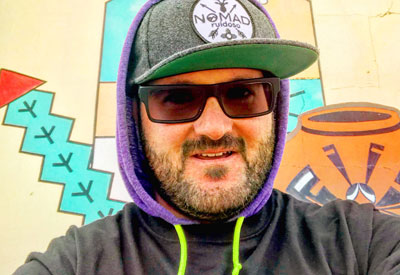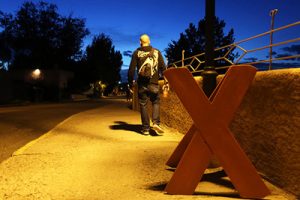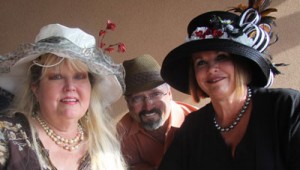 July 25, 2018 – For some time now, I have been curious about new art coming out of Taos Pueblo and the other northern pueblos of New Mexico – art made today, not the traditional pottery and jewelry we’ve come to know as fine, functional art objects.
July 25, 2018 – For some time now, I have been curious about new art coming out of Taos Pueblo and the other northern pueblos of New Mexico – art made today, not the traditional pottery and jewelry we’ve come to know as fine, functional art objects.
In 2016, FarahNheight Fine Art gallery (pictured at right) opened on Paseo Norte and there I met gallerist Gregory Farah, someone who was passionate about “showing where the contemporary Native American art movement has been and where it’s going.” Two years later, in March 2018, the building sold and Gregory went virtual.
I invited Gregory to write a few BeyondTaos blog posts introducing Native New Mexico artists producing art today. This is the first installment. Read to the end to find a brief bio about Gregory Farah that will explain how he came to relate to these artists and devote this part of his life to showing their work.
Janet Webb, BeyondTaos
Lynnette Haozous, Apache and Taos Pueblo
 Lynnette Haozous is Chiricahua Apache (of the San Carlos Apache Tribe), Dine, and Taos Pueblo.
Lynnette Haozous is Chiricahua Apache (of the San Carlos Apache Tribe), Dine, and Taos Pueblo.
Haozous is a multi-medium “artivist”, blending art and advocacy to bring attention to the current social conditions and injustices in Indian Country. Mediums include working with acrylics, water colors and spray paint. Haozous has also been an art teacher at OFFCenter Community Arts Project and at Working Classroom Inc., both in Albuquerque.
Haozous’s mural works include Nativo Lodge Room 519, Hotel Chaco rug mural, the OT Circus Gallery mural, and FarahNHeight Fine Art Gallery. Haozous is currently an Artist-in-Residence, working on three on-site murals at a newly built artist residence in Costilla, New Mexico, through FarahNHieght Fine Art Gallery. She was recently awarded the 2018-2019 Santa Fe Art Institute Truth and Reconciliation Artist Residency which she will begin in the fall of 2018.


Bobby Bales, Taos Pueblo
 Bobby Bales is a contemporary Native American artist from Taos Pueblo. Along with watercolor and acrylic painting, Bobby is also an experienced drum maker. Bobby learned this art form by working alongside his uncle Frank Mirabal, who is a third-generation drum maker. Bobby has participated in many top Native American art shows across the United States including the Eiteljorg Museum Indian Market, the Autry Intertribal Arts Market, and the Red Earth Festival.
Bobby Bales is a contemporary Native American artist from Taos Pueblo. Along with watercolor and acrylic painting, Bobby is also an experienced drum maker. Bobby learned this art form by working alongside his uncle Frank Mirabal, who is a third-generation drum maker. Bobby has participated in many top Native American art shows across the United States including the Eiteljorg Museum Indian Market, the Autry Intertribal Arts Market, and the Red Earth Festival.


Dawning Pollen Shorty, Taos Pueblo
 Dawning Pollen Shorty is a talented sculptor and painter from Taos Pueblo. Her father, Robert D. Shorty, is an award-winning sculptor, writer and dancer. Her mother, Bernadette A. Track, studied modern dance and ballet at Juilliard and was one of R.C. Gorman’s muses and models.
Dawning Pollen Shorty is a talented sculptor and painter from Taos Pueblo. Her father, Robert D. Shorty, is an award-winning sculptor, writer and dancer. Her mother, Bernadette A. Track, studied modern dance and ballet at Juilliard and was one of R.C. Gorman’s muses and models.
Dawning was educated in the arts at the Institute of American Indian Arts (IAIA) and at the University of New Mexico. She has won many awards for her micaceous clay female figures. In addition to being an artist, she is a longtime art educator in the Taos Public Schools.


David Naranjo, Santa Clara Pueblo
 David Naranjo is a contemporary Puebloan artist who works in multiple mediums to depict cultural symbolism through pottery designs and geometric linear work. Currently, his work mergers traditional pueblo aesthetics combined with nontraditional materials and elements to create meaning and purpose in each composition. David is from Santa Clara Pueblo and recently received his BFA at the Institute of American Indian Arts. David will be having a solo show at FaraHNHeight Fine Art Gallery Nov-Dec 2018.
David Naranjo is a contemporary Puebloan artist who works in multiple mediums to depict cultural symbolism through pottery designs and geometric linear work. Currently, his work mergers traditional pueblo aesthetics combined with nontraditional materials and elements to create meaning and purpose in each composition. David is from Santa Clara Pueblo and recently received his BFA at the Institute of American Indian Arts. David will be having a solo show at FaraHNHeight Fine Art Gallery Nov-Dec 2018.
The artist says of his work: “My inspiration has come from learning the Tewa language. While learning the language, I obtained a deeper understanding and connection to our cultural practices and found that a lot can be said with few words because you speak from your heart. I found our way of life to be a form of poetry and seek to show understanding and respect while making art as a form of prayer and ceremony. ”


About Gregory Farah
Gregory Freeman Farah was born in Albuquerque in December 1980 and raised in Los Ranchos de Albuquerque where he lived until 1999.
Gregory’s mother’s side of the family raised cattle in Lincoln County, New Mexico since the 1950s. His father, after attending AUB (American University of Beirut), attended Columbia in New York City and that is where the Farah from Gaza met the Scottish Irish woman from Chicago and together they began their journey to New Mexico.
Although Gregory was born and raised in New Mexico, he has had a life of moving around. He attended collage in Portland, Oregon and New Orleans, where he received a BFA in Middle Eastern History and minor in art from Tulane. After attending academic programs in Southeast Asia and South America, he settled in El Paso, Texas long enough to receive an MBA from the University of Texas.
It was the R.C. Gorman (1931-2005) Estate that brought Gregory to Taos in 2010. He ran the Navajo Gallery on Ledoux Street for a few years. (This is where I actually first met Gregory. Webb Design had worked with the gallery since the mid 1980s. At the time I did not recognize his spark of interest in the artists who followed in RC’s footsteps.) In 2013, Gregory helped the Estate open the new Navajo Gallery in Santa Fe. “I credit my time with the Estate with giving me a foundation and understanding of the contemporary Native American art movement, introducing me to RC and his contemporaries, many of the legends who laid down the groundwork for the movement. I really wanted to promote up-and-coming younger artists; find the next T.C Cannons, Oscar Howes and Helen Hardens.”
And so, in 2016 he opened FarahNHeight Fine Art in Taos.
FaraHNHeight went full nomad in early 2018 when there original gallery building on Paseo del Pueblo Norte was sold. Now FaraHNHeight sells online, collaborates with existing business, curates art programs and organizes pop-up exhibitions in in Taos (Old Martina’s Hall, Sagebrush Inn, Taos Ale House and Taos Ski Valley), in Santa Fe (“FaraHNHeight Fine Artist’s” on 223 Canyon Road, Noisy Water Wine Bar on 219 W San Francisco St, and soon an auxiliary showroom at 618 Paseo de Peralta), and in Albuquerque (Gobble This Restaurant in Old Town 308 San Felipe St NW, and Arogya Center 2500 Central Ave SW).
“I would not be an art dealer in any genre of art other than Contemporary Native American art. To me it’s the most American of art. It takes aspects of sacred folk art, traditional arts, and the spirituality of the indigenous people of these lands we call the Americas. It’s based on the symbiotic relationship of the human experience and the environment. I use the metaphor of American Blues music to explain contemporary Native art. The Blues come from a tragic history of colonialism, enslaving people against their will, force-feeding Christianity and puritanical beliefs. You get country blues and gospel music that, through the African-American community, eventually mutated and became contemporary rock and roll. Well, I look at the Contemporary Native American art movement in a similar fashion. There is something sacred, there is something not to be trifled with, within this artistic movement.”
Gregory continues, “These artists are moved by where they come from and what they see, the power of their elders, iconography, and designs that have been handed down from generation to generation. These contemporary artists use traditions as a template to incorporate into something new, a fusion of elements – street art, hip-hop culture or classic fine art lessons learned in school or seen in books – and they put it all together and make their own voice.”
Learn more about Gregory Farah and his stable of contemporary Native American artists on Facebook.



